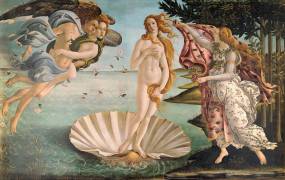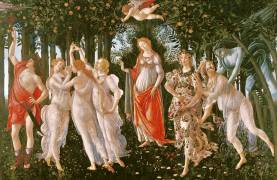Shop art print and framed art Athena Pallas and the Centaur by Sandro Botticelli
Customise
Your art print
Athena Pallas and the Centaur OF Sandro Botticelli
Athena Pallas and the Centaur
Historical background to Pallas and the Centaur, an intriguing work by Sandro Botticelli
At the end of the 15th century, Sandro Botticelli was one of the most important painters of the Florentine Renaissance, a period that profoundly influenced our modern conception of beauty and aesthetics, and was then particularly renowned for his paintings featuring religious allegories. From 1478 onwards, the artistic movement of the "First Renaissance" then sought to rediscover and reinvigorate the intellectual and aesthetic heritage of ancient Greece and Rome, which had been largely lost during the Middle Ages.
In this context, taking a figure from Greek-Roman mythology as his subject was a natural choice for Botticelli. After painting Spring, a canvas commissioned by Lorenzo di Pierfrancesco, the Tuscan painter set to work in 1482, for the wedding of his first patron, on a painting featuring Athena, goddess of wisdom and war, also known as Pallas, facing the centaur, a half-human half-horse creature.
Visual description of Pallas and the Centaur
Measuring 207x148cm, this painting currently in Florence's Uffizi Gallery depicts an epic scene between the goddess Pallas Athena and a centaur, highlighting the striking contrast between these two mythological figures.
The Goddess Athena is depicted dressed in a long, transparent gown displaying the intertwined rings, a representation of the insignia of Lorenzo de' Medici, Prince of Florence, cousin of Lorenzo di Pierfrancesco, and probable commissioner of the painting. The calm, serene face of the divinity expresses her intellectual and spiritual nature, and on her head rests a crown of foliage, extending all the way down to her body. Pallas Athena sports a face and forms reminiscent of the prized female portraits of the Renaissance, Botticelli having no doubt been inspired by Simonetta Vespucci, a Florentine noblewoman renowned for her beauty.
Concerning the Centaur, this fantastic creature here symbolises man's wild and instinctive impulses. He holds a bow in his hand, while his fleeting gaze and the position of his head indicate his submission to the goddess. This dramatic scene is intensified by Athena's gesture, as she grabs the centaur's hair with one hand to control him. The vivid colours and delicate rendering of detail make this painting one of the major works of the early Renaissance, taken as an example by many painters thereafter.
The interpretations of Pallas and the Centaur by Sandro Botticelli
One of the main themes suggested by this scene is the perpetual struggle between intellect and instinct, represented respectively by Athena and the centaur. The confrontation between these two characters shows a profound metaphor for the rivalry between the human spirit and its animal nature. This idea also reinforces the ideal of humanist and classical culture, where the dominance of knowledge must take precedence over that of ignorance in order to achieve a harmonious and enlightened life.
Some historians have also suggested that this painting might have a political dimension. Indeed, the Medici, the powerful family reigning over the Florentine Republic, were great patrons of Botticelli. In particular, Lorenzo de Medici had gathered around him renowned scholars and artists. The figure of Athena could thus represent the Medici's wisdom and mastery in the face of their enemies, embodied by the furious centaur. This message was a way for the artist to celebrate his protective family while underlining its values.
An alternative interpretation has been proposed in which the painting reflects Neoplatonic ideas, popular among Florentine intellectuals at the time. This philosophy was based on the distinction between the sensible and the intelligible, valuing the spirit above the body. Thus, Athena Pallas would symbolise the principle of the good and the spiritual, dominating the centaur representing the material aspect.
Role of Pallas and the Centaur in Botticelli's career
Pallas and the Centaur marked an important turning point in Botticelli's career, as he began to establish himself as one of the most daring and innovative artists of his time.
While Sandro Botticelli is today best known for his iconic works such as The Birth of Venus and Spring, this painting represents one of the artist's first forays into the representation of mythological themes, which would later become an integral part of his visual language. Botticelli also bent the conventions of Florentine art with a technical virtuosity and compositional daring that earned him international renown.
Pallas and the Centaur is a striking example of Sandro Botticelli's talent for allying formal beauty and symbolic depth. The intriguing confrontation between these two mythological protagonists sheds light on the complexity of the ideas that animated the humanist spirit of the Italian Renaissance, and continues to challenge our imagination today.
This artwork is a painting from the renaissance period. It belongs to the italian renaissance style.
« Athena Pallas and the Centaur » is kept at Galleria degli Uffizi, Florence, Tuscany, Italy.
























